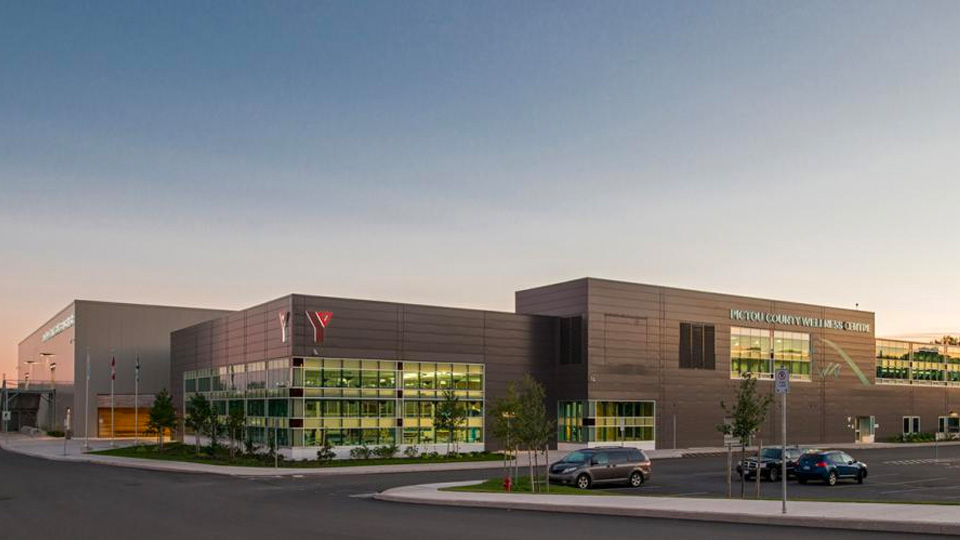
Summary
Following the destruction left by Hurricane Fiona, Pictou County relied on a local recreation centre to serve as a temporary shelter for incoming power crews. Plans to upgrade the facility will ensure continued resilience during future climate-related extreme events, illustrating how energy and accessibility upgrades can help turn a community building into a resilience centre.
Background
The Pictou County Wellness Centre (PCWC) is a multipurpose sporting facility located in the heart of Pictou County, N.S. Built in 2012, it features two NHL-sized hockey arenas, an Olympic-sized swimming pool, a fitness centre and a gymnasium. The PCWC hosts much of the County’s athletic programming, offering a space where residents can engage in physical activity while building community ties.
When Hurricane Fiona hit Pictou County in September 2022, violent winds and heavy rainfall caused extensive damage, including tearing roofs off homes and flattening crops. The storm wreaked havoc on critical infrastructure such as electrical wires and transmission lines, leaving most residents without power. For many, the outage lasted a gruelling 10 days. The Pictou County Wellness Centre was the first facility to have power restored, allowing it to act as a resilience hub and serve as a lifeline for community members when they needed it most.
Turning a recreation centre into a resilience hub
As awareness spread of the extent of damage to electrical infrastructure in northeastern Nova Scotia, power crews poured into the area from New Brunswick, Newfoundland, Quebec, Ontario and New England—but had nowhere to stay. It became clear that as one of the few facilities with working electricity, the PCWC could host this inflow of electrical workers. Despite its small staff of seven, the facility welcomed power crews with open arms and served as temporary accommodation.
The centre brought in 100 cots, installed portable toilets in the parking lots and made use of the showers in the arenas. The kitchen equipment was fully utilized to provide hot meals, and the centre arranged for dumpsters for cleanup janitorial services. The small staff team committed to their role and ensured power crews were cared for and met with hospitality and gratitude.
The centre was also able to support individual community members. With power outages across the County, some residents came to the PCWC to charge their phones, allowing them to connect with friends and family or call for assistance if required.

After Hurricane Fiona, the community turned to the Pictou County Wellness Centre for support.
Next steps
To enhance the PCWC’s ability to provide a space where people feel safe, supported and connected during times of uncertainty, the centre will be retrofitted through financing from the federal government’s Hurricane Fiona Recovery Fund. This fund will support renovations for 34 climate comfort centres across Pictou and Antigonish counties and will include communication systems, improved accessibility, better volunteer training and resources and the purchase and installation of a generator. Upgrades to the PCWC will help improve the facility’s emergency preparedness and reduce community vulnerability.
In addition, the PCWC is well equipped to improve the building’s energy efficiency, thanks to a feasibility study completed prior to Hurricane Fiona with support from the Federation of Canadian Municipalities (FCM). While installing a generator will offer essential backup power, incorporating energy-efficient upgrades such as insulation improvements and high-efficiency windows will further strengthen the building’s resilience against extreme weather. These improvements will also reduce heating and electricity costs, freeing up resources that can be redirected to other community services or emergency funds.
Lessons learned
The case of the PCWC illustrates the importance of considering resilience when retrofitting community buildings. By designing facilities to serve beyond their day-to-day purpose, municipalities can ensure these spaces remain functional during unexpected events.
Resilience-focused upgrades—such as energy-efficiency improvements and backup power systems—can:
- help buildings maintain safe, livable conditions during extreme weather
- expand their capacity to shelter people in place
- improve occupant safety and comfort
- support grid reliability when systems are under stress
These elements position community facilities to operate as temporary shelters in times of crisis, ultimately strengthening a municipality’s ability to respond to and recover from climate events.
Resources: Community building retrofits
Guides: Equity and non-energy benefits of community building retrofits
Explore how retrofits can build more equitable and resilient municipalities.
Read moreFactsheets: Community Buildings Retrofit initiative
How to retrofit existing community buildings to lower GHG emissions and extend their life cycle.
Read moreGuide: Taking your indoor swimming pool to net zero
Key measures and lessons learned to help you build a net-zero plan
Read moreGuide: Taking your indoor ice rink to net zero
Learn how to develop an actionable roadmap to net zero ice rinks
Read moreSustainable community and municipal buildings
Save on energy costs with energy upgrades and new sustainable builds.
Read moreCommunity Buildings Retrofit Advisory Service
Free, expert advice to help you upgrade your local facilities
Read more
